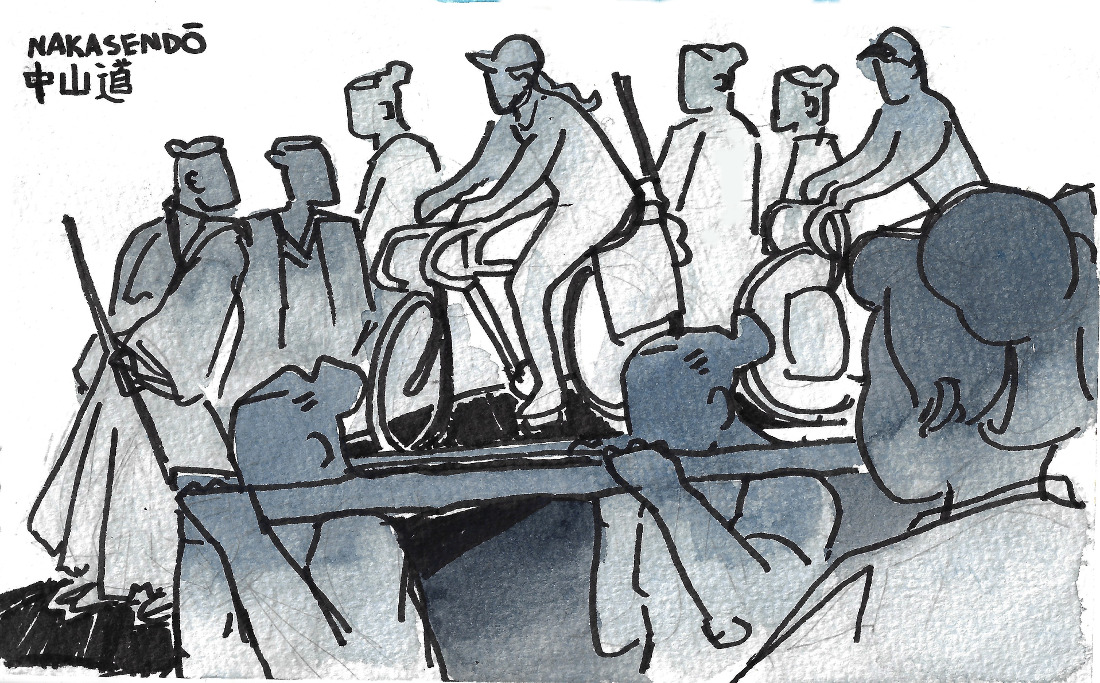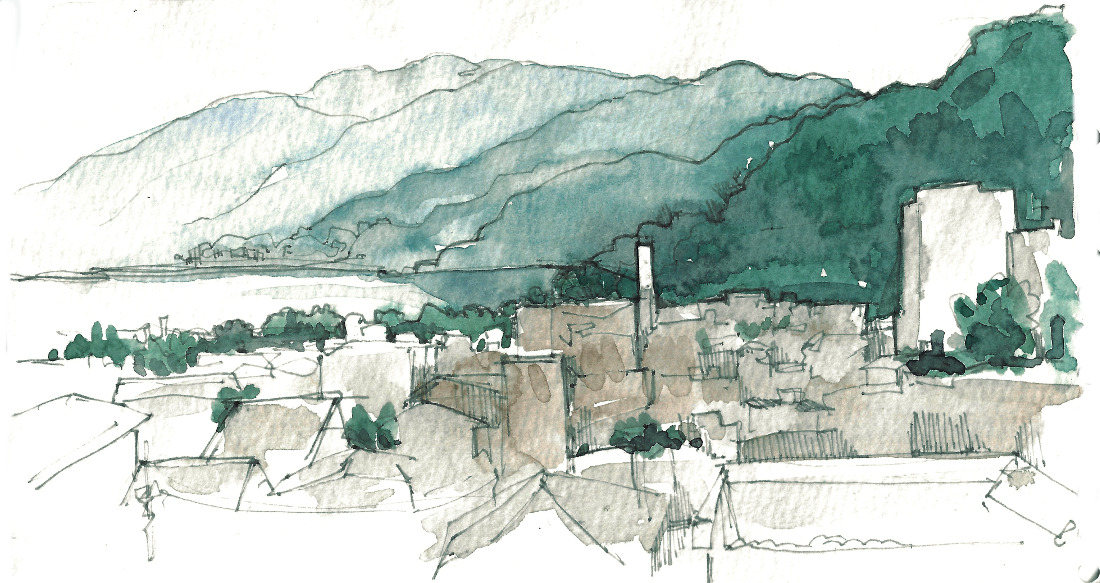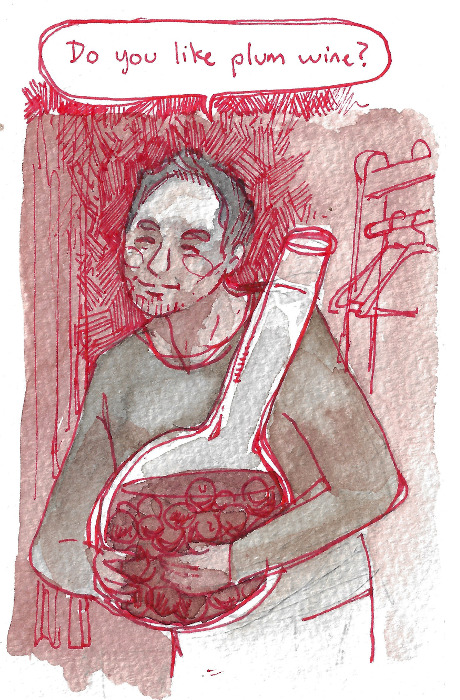The morning after we reached Tokyo, I lay in my hostel bunk listening through an open window to the city street noises muffled by heavy rain. I began to regret the large quantity of celebratory sake that I had consumed the previous evening.
We had put together a laundry list of things to do in Tokyo, the last stop for us before leaving Japan, but for the next few days, most of our energy went into winding our bodies down from the ordeal of the journey.
We did manage to accomplish some tasks, however. We made a pilgrimage to Blue Lug, a famous bicycle shop, and shopped for souvenirs for our friends and family. We relaxed in our hostel and caught up on much-needed sleep.
A few days later, Amy’s cousin Jenn arrived from America on a work trip. A seasoned traveler, Jenn was a fantastic source of the touristic energy required to kick us out of our complacency.
The next day, Jenn, Amy and I began with a tour of the Japanese National Gallery. I had been excited about looking at the famous katana collection housed in that museum – many of which are considered national treasures. However, I was dismayed to find I responded quite negatively to the cold, unmounted steel blades before me, kept sharp and polished despite their extreme age. Alien, almost identical, I wondered how many people had met their end at the hands of these well-designed obelisks of death. Far more interesting were the painted screens – beautiful arching landscapes of drooping wisterias and gilded waterfalls, and the wood block prints of the late Edo period. The museum was a restrained and focused tour through the history of Japan from the perspective of its art.
After a lunch detour to the famous Tsukiji fish market, we found ourselves walking through the tall cedar trees of Yoyogi park towards the famous Meiji Jingu shrine. The atmosphere here was almost rural; a seven foot long snake poked its head out from under a park bench before scurrying into the underbrush. The shrine was full of foreigners, but like most Shinto shrines, it functioned more as a park for one’s spritual and emotional well being than a mark of belonging, and we didn’t feel excluded as we purchased a wooden block to write a blessing on.
As we walked towards the center of the shrine after ritualistically washing ourselves, we heard the muffled silence of tourists as a traditionally dressed Japanese couple processed with their relatives into a private courtyard, surrounded by preists, on their wedding day.
I looked at Amy and was reminded of how we had grown closer to each other on this trip, which began with our own wedding almost a year ago. It was with a great sense of purpose that Amy, Jenn and I wrote three messages on the wooden block and hung it on shrine to be ritualistically burned the next morning.
We descended from the peace of the shrine to the busiest area of Tokyo, Shibuya.
The crush of people in Shibuya was overwhelming. We headed towards the famous Shibuya Scramble. The scramble is a huge intersection that is shut down for people to cross in every which way between the multiple train and subway stations under the road.
We joined the crowd and crossed the street to admire the statue of the famous dog, Hachiko, who was kept company by two live, immobile cats perched between his paws. Suddenly, we encountered our friend Justin, who Amy had met in San Francisco, and who had given us many pointers on traveling to Japan. What a strange coincidence to run into a person you know in the midst of the busiest place in the densest city on earth!
The following day was our last before our flight. This was the day that we had to take our bicycles, which were a method of transporting our worldly possessions, and convert them into two very large, ungainly boxes. Our possessions, and boxes, would then somehow have to get to Haneda airport, which was not reachable via bicycle. We said goodbye to Jenn, and began the all-day process of packing our things.
Our strategy was to pick a location that was walking distance from a cheap hotel, a bike shop (to obtain bike boxes), and an ‘express bus’ line to Haneda airport (which would have the under-cabin storage we needed to transport our ridiculously bulky and heavy bike boxes). We succeeded in finding a lovely bike shop, who not only gave us boxes, but brought us cold tea, and successfully packed our bikes over several hours. What we didn’t consider was that walking a distance on foot, and walking that same distance while hauling four fifty-pound boxes with no wheels, are two different concepts. Perserverence, and a dolly from the hotel, saved the day, and the next morning we found ourselves at Haneda waiting for our flight.
Both of us felt that it was time to leave Japan. Japan had been amazing, beautiful, and wonderfully kind to us, but we had seen enough, experienced enough. It was time to go somewhere different.
The return back to America was a blur. We spent a week getting over jet lag and slowly unpacking our bikes while residing on our friend George’s couch in Brooklyn. Next, we took the train to Boston, and spent another week with Joan and Wayne, Amy’s parents, in Bedford, Massachusetts.
Finally, on the weekend of June 10th, we took our bicycles out for a three day tour that we’ve done every year for the past three years, from Cambridge, Massachusetts to Provincetown at the tip of Cape Cod. The ride took two days, and we were joined by a dozen other people. We camped as a group just over the Bourne bridge in Shawne Cromwell state park, and again the next night at a campground in P-Town. Some of the riders were old friends, like George, that we’d known for a decade, and the rest were new friends that we were happy to meet and share a bit of scenic beauty, suffering and glory with.
One of the most memorable moments of the ride occurred during the middle of day one, when we had stopped for lunch as a group at a park overlooking a massive wetlands. We watched in horror as a huge snapping turtle (two to three feet long (no, at least five feet!)) emerged from the swamp and began slowly crawling towards us. Between us and the swamp was a road with a fair amount of traffic. We feared for the turtle, but feared more for our fingers if we tried to move him. Suddenly, an unidentified hero in a baseball hat stopped his truck, grabbed the turtle by the base of its shell, and dragged it out of traffic, as its claws audibly scraped the asphalt.
We reached Provincetown the evening of the second day, and enjoyed a celebratory party with friends new and old.
Amy’s grandparents planned to retire on the Cape in Truro, and they built a small house there in ’70sthat’s still in the family. After a night in P-Town, we biked a few miles back up the Cape to the house and parked our bikes. We spent a month relaxing there. Amy painted and baked bread, while I volunteered and worked on projects in the basement. When it was time to leave, we rode much of our trip in reverse, and ended up back in Somerville, Massachusetts.



